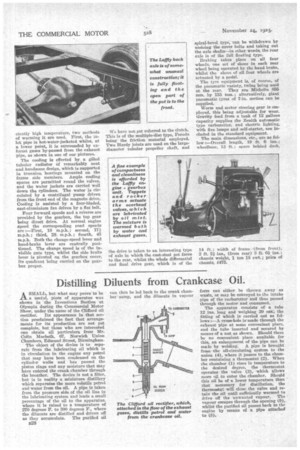Distilling Diluents from Crankcase Oil.
Page 12

If you've noticed an error in this article please click here to report it so we can fix it.
ASMALL, but what may prove to be a useful, piece of apparatus was shown in the Inventions Section at Olympia during the Commercial Motor Show, under the name of the Clifford oil rectifier. Its appearance in that section proclaimed the fact that arrangements for its production are not yet complete, but those who are interested can obtain all particulars from Mr. Colin Macbeth, 67, Norwich Union Chambers, Edmund Street, Birmingham.
The object of the device is to separate from the lubricating oil which is in circulation in the engine any petrol that may have been condensed on the cylinder walls and has passed the piston rings and any moisture that may have entered the crank chamber through the breather. The device is not a filter, but is in reality a miniature distillery which separates the more volatile petrol and water from the oil. A pipe is taken from the pressure side of the oil line in the lubricating system and leads a small percentage of the oil to the apparatus. where it is raised to a temperature of 270 degrees F. to 300 degrees F., where the diluents are distilled and driven off as they accumulate. The purified oil
P28 can then be led back to the crank chamber -sump, and the diluents in vapour form can either he thrown away as waste, or may be conveyed to the intake pipe of the carburetter and thus passed through the motor and constunerL
The apparatus consists of a tube 12 ins, long and weighing 30 ow., the fitting of which is carried out as follows :—A cross-hole is made through the exhaust pipe at some convenient place, and the tube inserted and secured by means of a nut as shown. Should there be no convenient place available for this, an enlargement of the pipe can be male by welding. A pipe is brought from the oil-circulating system to the union (4), where it passesto the chamber containing a thermostat (2). When the chamber (1) rises in temperature to the desired degree, the thermostat operates the valve (3), which allows more oil to enter the chamber. Should this oil be of a lower temperature than that necessary for distillation, the thermostat will close the valve and retain the oil until sufficiently warmed to drive off the unwanted vapour. The vapour escapes through the opening (9), whilst the purified oil passes hack to the engine by means of a. pipe attached to (8).




































